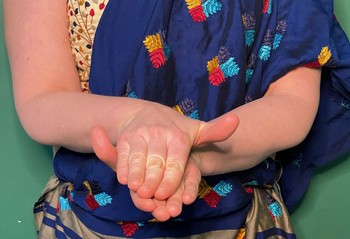Makara
Saṃyuta Hasta - Double Hand Gestures
Descriptions and Meanings
9:146
Two Pataka hands are turned down and placed on each other with the thumbs kept raised. This is Makara hand resembling shark.
9:147:
Its employment is for the representation of lion, tiger, elephant, crocodile, shark, fish and flesh eating animals.
9:145
Makara—When the two Patāka hands with their thumbs raised are turned down and placed on each other the Makara hand is produced.
9:146:
It is used to indicate lion, tiger, elephant, crocodile, shark and fish and other carnivorous animals.
26:64-65
When two Patāka hands are placed one over the other (on the head) and facing downwards, the combination is Makara Hand.
26:64-65:
It shows the actions of lion, tiger, deer, etc.
No verse annotation
Makara: Ardha-candra hands, one enclosing the other, palms downwards, the thumbs moving. Patron deity Mahendra.
No verse annotation:
the sea, overflowing of a river, deer-face, prosperity, solidity, platform, crocodile.

Ardhaçandra - No verse annotation

Ardhaçandra - No verse annotation
Not included elsewhere
8:524-525
If two Ardhacandra hastas - one enclosing the other, palms downwards and the thumbs moving - then it is Makara (=crocodile) hasta. Its patron deity is Mahendra.
8:524-525:
This hasta is used to denote the flow of a river in spate (sea, river overflowing - AKS), deer face, prosperity, solidarity, platform and crocodile.
4:1229-1232
Makara: The two hands which are in Patāka Hasta face opposite directions and are joined at the wrists.
4:1229-1232:
This Hasta is used to depict using weapons in war. The same Hasta with the fingers separated and pointing upwards is used to show a blossoming lotus flower. When held sideways it is used to depict children in salutation and short objects.
7:78
Makara: If the pataka hasta formed in both hands are kept upon the both wrists, facing upward, it is makara.
7:78:
This is applied to show lion, śārdula (fierce animal) and crocodile.
2:192
Patāka hastas are placed one over the other from the wrist. The thumbs are raised and the other fingers are held separately to form the makara hasta.
2:193:
A hunting leopard, snake, lion, crocodile and other acquatic animals, demon, flow of river, et al can be depicted with makara hasta.
:74
If the two hands in the form of two Pataka hastas, facing each other, are placed one above the other, the two thumbs sticking up, it is Makara hasta, bringing pleasure to Subhatikara.
:811:
A lion, a tiger, a crocodile, other quadrupeds, a demon, a killer, the cruel, Rahu,
:812:
the mouth of a lion, the mouth of an elephant, the month of Caitra, a limb, a fish, an alligator, the Fish incarnation of Visnu—in these is Makara applied.
:813
When Makara is pushed forward with cruelty in the eyes,
:813:
it denotes the subjects from‘a lion’to‘the cruel’.
Not included elsewhere
:814
If Makara is held up very high,
:814:
it means Rahu.
Not included elsewhere
:814
If Makara moves quickly forward,
:814:
it means the mouth of a lion.
Not included elsewhere
:814
If Makara is hung down,
:814:
it means the mouth of an elephant.
Not included elsewhere
:815
If Makara is held up a little high,
:815:
it is the month of Caitra.
Not included elsewhere
:815
If Makara is held near the eyes,
:815:
it means a limb (or sensory organ) of the body.
Not included elsewhere
:815
If Makara moves with the movement of a fish,
:815:
it denotes a fish or an alligator.
Not included elsewhere
:816
By putting Makara on the head with a little movement forward
:816:
Subhankara suggests the Fish incarnation of Visnu.
Not included elsewhere
7:108
Makara [occurs when] two [ardha] candra hastas are placed one above the other, palms turned down.
3:457-458
In makara hand, two patāka hands are joined [and placed one] on top of the other and turned down with the thumb pointing upwards.
3:457-458:
This hand[gesture] is used to represent a crocodile, a shark etc., a tiger, a lion and other carnivorous animals, etc. as well as the flood of a river.


